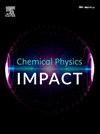Plant-mediated biosynthesis of Nickel (II) oxide nanoparticles from Calpurnia Aurea Leaf extract: A promising photocatalyst for malachite green degradation
IF 4.3
Q2 CHEMISTRY, PHYSICAL
引用次数: 0
Abstract
The current work investigation involves the synthesis of NiO NPs using Calpurnia Aurea leaf aqueous extract-based phytocompounds as NPs facilitating agents for application as effective photocatalyst in the degradation of MG. The obtained NiO NPs were characterized using various techniques, including FTIR, XRD, and SEM. The XRD analyses of NiO NPs indicated the crystalline nature of NiO NPs showed that face- center cubic structure with the average crystalline size, the specific surface area, and percent of crystallinity are 17.61 nm, 49.5 m2/g, and 91.4 % respectively. FTIR analysis showed the presence of a stretching frequency peak at 438 and 557cm-1, confirming the Ni–O band stretching. Results demonstrated that NiO NPs showed high photo-catalytic rates with 98.17 % degradation of Malachite green (MG) within 30 min under visible light irradiation. Moreover, NiO NPs calcined at 400 °C was more efficient photo-catalyst than the other NiO NPs calcined at 300 °c, and 500 °C with 1.41, and 2.96 times higher kinetic rates for the removal of MG, respectively. The active species involved in degradation process were systematically investigated and a photo-catalytic mechanism was proposed. In addition, NiO NPs showed good recyclability and reusability of resistance to photo-corrosion even after 120 min of consecutive photo-catalytic activity. Overall, the green synthesized NiO NPs exhibited considerable potential for fast and eco-friendly removal of harmful organic dyes.

金莲叶提取物中氧化镍纳米颗粒的植物介导生物合成:一种有前途的降解孔雀石绿的光催化剂
目前的研究工作是利用金盏花叶水提取物为基础的植物化合物作为NPs促进剂合成NiO NPs,并将其作为有效的光催化剂用于MG的降解。采用FTIR、XRD、SEM等技术对所得NiO NPs进行了表征。对NiO NPs的XRD分析表明,NiO NPs的晶型为面心立方结构,平均晶粒尺寸为17.61 nm,比表面积为49.5 m2/g,结晶率为91.4 %。FTIR分析显示,在438和557cm-1处存在拉伸频率峰,证实了Ni-O波段的拉伸。结果表明,在可见光照射下,NiO NPs在30 min内对孔雀石绿(MG)的降解率高达98.17 %。此外,400 °C煅烧的NiO NPs比300 °C和500 °C煅烧的NiO NPs更有效,脱除MG的动力学速率分别提高1.41倍和2.96倍。系统地研究了参与降解过程的活性物质,并提出了光催化机理。此外,NiO NPs在连续120 min的光催化活性后也表现出良好的可回收性和耐光腐蚀的可重复使用性。总体而言,绿色合成的NiO NPs在快速、环保地去除有害有机染料方面表现出相当大的潜力。
本文章由计算机程序翻译,如有差异,请以英文原文为准。
求助全文
约1分钟内获得全文
求助全文
来源期刊

Chemical Physics Impact
Materials Science-Materials Science (miscellaneous)
CiteScore
2.60
自引率
0.00%
发文量
65
审稿时长
46 days
 求助内容:
求助内容: 应助结果提醒方式:
应助结果提醒方式:


